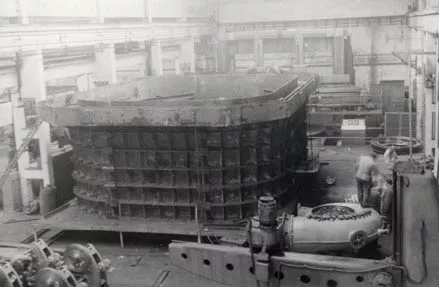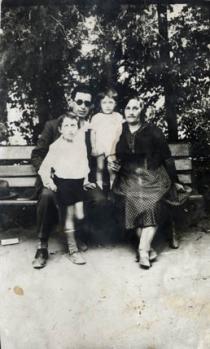This is the furnace for carbide in Devnya, 1964.
When the furnace was started for the first time, it was sheer luck that we survived. The furnace had to be drilled with an electrical arc electrode. We started the furnace, but the workers could not make the hole for one whole day. At the same time the lava was filling the tub of the furnace. According to the design plans there is a steel crane where the worker with the electrode is, which is cooled by water because the temperature is very high. That water passes through some hoses. On the third day when the worker made the hole, the flow of lava turned out to be very strong because of the high pressure which had built up inside. It poured on the floor and the hoses melted from the high temperature and the water inside them poured out too. Water and carbide make acetone, which explodes. But the mist was so dense that there was not enough oxygen for an explosion. We all survived by mere coincidence.
We stopped the water, the mist cleared, but the carbide was being cooled in a revolving drum 102 meters long, over which water is poured. A colleague of mine had designed it, but he had calculated the volume of necessary water on the basis of the data for the output, which I had given to him. Yet, that output turned out to be 6-7 times higher. The drum started getting red. If it were torn, everything would explode in a second. Dmitriy, the consultant on the project from the Russian side and I sat there and waited until the flow subsided and it was certain that the drum would hold. If the drum exploded, the staff and we would be dead in an instant. No mistake about that. Maybe when the workers built the furnace, they made it more difficult to be drilled. Dmitriy was a very nice boy at my age. He was from Karaganda [an industrial city in central-eastern Kazakhstan - at that time part of the USSR]. There were a number of such furnaces in Karaganda. He said to me, 'I have done that a lot of times and never has such a thing happened to me.' Our first white hairs are from this experience. But once the furnace was started, there were no more problems with it. It worked without failure for nine years. That furnace is in the plant producing polyvenilchloride in Devnya.
We returned to Sofia and instead of being thanked for everything, some incompetent and gossipy person was promoted to chief engineer. I was group leader of the machine construction department in 'Himmetalurgproekt'. That was in 1964. The chief of the department was a very good friend with that man Petko Hristov and brought him from Dimitrovgrad to Sofia. Probably Petko had been a very good engineer in Dimitrovgrad, but he was not a good constructor. So, he started making intrigues. All of the group leaders including me resigned. Only Marin Ivanov Marinov remained working for him and Petko started gossiping against him too. At that time, in 1965 I wanted to emigrate to Israel. I have a nerve condition ever since Somovit.
My nervous system is shattered and I had a nervous breakdown again. My physician advised me to change the atmosphere. I quit the job and became a teacher in an evening technical school in Sofia. I applied for emigration, my wife also agreed. I was already married and had children. But the authorities refused to let me go. Later I found a way to discover the reason - it was because I had designed installations for the military plants in Sopot, Kazanlak and Karlovo - furnaces, in which ingots, which are later used to produce shells. My group made designs for the military plants and that was why I was not allowed to emigrate.
The furnace for carbide in Devnya, 1964.
Share
Photos from this interviewee
The Centropa Collection at USHMM
The Centropa archive has been acquired by the United States Holocaust Memorial Museum in Washington, DC.
USHMM will soon offer a Special Collections page for Centropa.
Academics please note: USHMM can provide you with original language word-for-word transcripts and high resolution photographs. All publications should be credited: "From the Centropa Collection at the United States Memorial Museum in Washington, DC". Please contact collection [at] centropa.org.





























